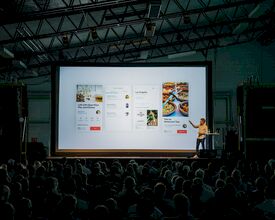There are lots of disappointing experiences people may have when attending an event, but there’s nothing worse than listening to a world-known professional deliver an average speech accompanied by a low-quality presentation.
Unfortunately, this happens a lot, and you can’t always control it. You’ll invite awesome industry thought leaders as a way to bring people to your event, but then you end up giving your attendees a subpar experience because that speaker prepared a mediocre presentation.
How can you keep this from happening? After all, you can’t dictate to your speakers how to present or talk. This will be seen as intrusive and annoying, to say the least. But you also can’t let your speakers deliver weak presentations. After all, your event’s reputation is at stake. People won’t make a clear distinction between a bad presentation and your event. Instead, they’ll associate the presentation with your event brand and probably never attend another event of yours, or worse, tell others not to attend your events, either.
You must make sure that your speakers’ presentations are engaging, insightful, and meaningful. But how can you do that without making your speakers feel like you’re trying to control what they say and do? Here are some recommendations you’ll want to consider:
Brief your speakers on your audience
One of the biggest mistakes is not providing context to your speakers. Regardless of your industry, there are numerous niches and attendee types. Your speakers have to know the detailed profile of your attendees and what they’re seeking to learn, along with goals you want to achieve by running the event.
Let’s say, for example, that you’re running an event for solo entrepreneurs and how they can market themselves. You’ve invited a video marketing expert to speak, but you didn’t mention who your attendees are. How do you expect the speaker to adjust their narrative and presentation with the attendees’ profiles and needs? After all, a presentation will vary significantly depending on the profile of your guests.
Presenters will have a completely different narrative or approach if they’re speaking to solo entrepreneurs compared to SaaS marketers. So the moment someone agrees to speak at your event, send them a brief document explaining what your event is about, who your attendees will be, and the goals you want to accomplish.
Design a special presentation best practices document
A good way to get your speakers to create excellent presentations is by sending them a best practices document. This will establish the rules from the beginning and let your speakers know what their presentations should look like.
For example, you can describe the type of presentation you want and its dimensions. There’s nothing more annoying than someone displaying a standard-sized PowerPoint presentation (4:3) instead of a widescreen-sized presentation (16:9). You can also include a few other suggestions, such as the number of words per slide. This is a big one, since most people tend to create slides cluttering too many images and sentences. You can even send your speakers a PowerPoint or Keynote template to use.
Meet with your speakers before they start drafting their presentations
After sending a best practices document, schedule a meeting with your speakers. You can choose one-on-one meetings, or even better, schedule an online group meeting if possible, so that all of your speakers get the presentation requirements at the same time. Walk them through the best practices, show them some examples of great presentations, and answer any questions they may have. Plus, you can discuss the timing and length of each presentation.
Schedule a one-on-one meeting with your speakers once their presentations are ready
Ask your speakers to send over their presentations for approval and schedule one last meeting before the event to discuss what needs to be changed in each presentation. Most speakers will feel grateful to walk through their presentation and see what they need to change to make their presentation as attractive as possible.
But won’t they feel annoyed by how many meetings they need to have before the event? Not if you frame these meetings as an attempt to help them get the most out of the event. Also, remember that you’ll need to inform your speakers about the presentation protocol as soon as they agree to speak at your event, so they know what’s expected from them in advance and will have no problem working on their presentation with you.
Help your speakers with visual content if necessary
This happens a lot: Speakers will want to make their presentation more visually appealing, yet they’ll just go to Google and copy and paste low-resolution images. Or even worse, they’ll go to image stock banks such as Shutterstock or iStock and copy images with the stock logos on it. That’s unacceptable. Redirect your speakers to websites such as Unsplash or Pexels, where they can find free stock images of good quality.
Key takeaways
When planning an event, design a presentation protocol and send it your speakers as early as possible. Remember that this protocol should be straightforward and easy to apply. Assist your speakers every step of the way and let them know you intend to help them deliver a memorable speech and presentation.
Source: Photo by Teemu Paananen on Unsplash





